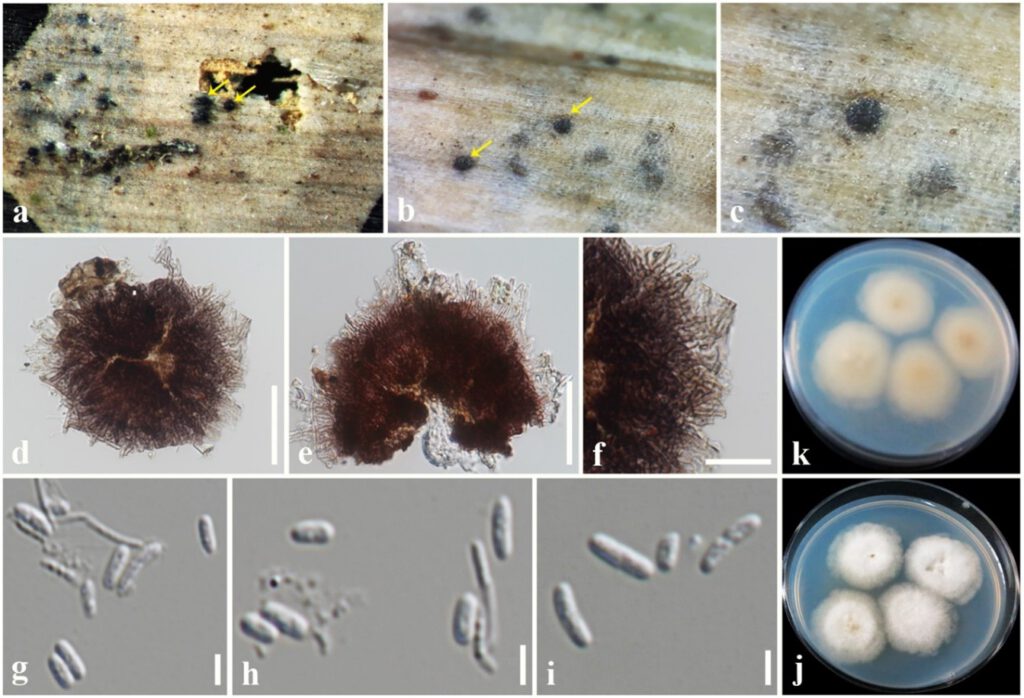Paramicrothyrium bambusae Tennakoon, S. Hongsanan & S. Lumyong sp. nov.
MycoBank number: MB; Index Fungorum number: IF; Facesoffungi number: FoF 11795; FIGURE 2
Etymology: — Name reflects the host genus Bambusa.
Holotype: — MFLU 19-2729
Epiphytic on the upper surface of dead leaves of Bambusa vulgaris Schrad. (Poaceae), appearing as small black dots. Sexual morph: Thyriothecia 90–120 × 100–130 μm ( = 110 × 112 µm, n = 10), solitary, superficial, scattered, flattened, circular, dark brown to black, poorly developed basal layer, easily be removed from the substrate, with prominent, central ostiole, slightly darker around the ostiole, dark brown towards the outer lighter rim, irregularly rounded at the margin. Upper wall comprising brown cells of textura angularis, radiating in slightly irregular, parallel lines from center to the outer rim. Conidiogenous cells evanescent. Conidia 3–4 × 1–2 µm ( = 3.7 × 1.2 μm, n = 30), unicellular, cylindrical with obtuse ends, hyaline, minute guttulate, straight or slightly curved, smooth-walled.
Culture characteristics: — Colonies on PDA, 10–12 mm diam. after 4 weeks at 25 °C, colonies from above: medium dense, circular, raised, surface smooth, entire margin, white to cream at margin, white at center; reverse: white to yellowish at margin, light brown at center. Mycelium white to cream with tufting.
Material examined: — Taiwan, Alishan Mountain, dead leaves of Bambusa vulgaris (Poaceae), 28 September 2018, D. S. Tennakoon, ADS046A (MFLU 19-2729, holotype); ex-type living culture, NCYUCC 19-0058. ibid. 29 September 2019, ADS046B (NCYU 19-0085, Paratype); ex-paratype living culture, NCYUCC 19-0344.
GenBank numbers: —LSU: XXXX; ITS: XXXX.
Notes: — The phylogeny indicates that Paramicrothyrium bambusae (MFLU 19-2729 and NCYU 19-0085) forms an independent lineage sister to P. chinensis isolates (IFRDCC2258 and IA20) with strong statistical support (100% ML, 99% MP, 1.00 BYPP, FIGURE 1). Morphology of Paramicrothyrium bambusae fits well with the type species in having circular, dark brown to black thyriothecia with an irregular ostioles without a darkened ring (Wu et al. 2011). However, only the sexual morph available for Paramicrothyrium chinensis and, hence we could not be compared with the asexual morph of P. bambusae (Wu et al. 2011). Therefore, we compared the base pair differences between Paramicrothyrium bambusae and P. chinensis and there were 25 base pair differences (4.14%) across 603 nucleotides across the ITS (+5.8S) gene region. In addition, Paramicrothyrium bambusae has smaller thyriothecia (90–120 × 100–130 μm), whereas P. chinensis has significantly larger thyriothecia (420–590 μm diam.) (Wu et al. 2011). However, further collections are essentially needed for clarify the sexual and asexual connection of Paramicrothyrium species.

FIGURE 2 Paramicrothyrium bambusae (MFLU 19-2729, holotype). a, b Thyriothecia on surface of leaf (yellow arrows). c Close-up of Thyriothecium. d, e Thyriothecium when, viewed in squash mount. f Upper wall of thyriothecium, when viewed in squash mount. g–i Conidia. j Colony from above (on PDA). k Colony from below (on PDA). Scale bars: d, e = 50 μm, f = 20 μm, g–i = 3 μm.
